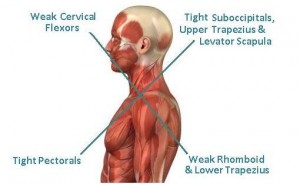Thoracic Outlet Syndrome (TOS) is a potentially painful and disabling condition of the upper extremity. It results from the compression of structures in the thoracic outlet, a space just above the first rib, and behind the clavicle (collar bone). Due to the range of signs and symptoms that can lead to a diagnosis of TOS, the incidence rates of the condition currently are unknown. Physical therapists work with individuals who have TOS to ease their symptoms and restore their upper-body function.
How Does Thoracic Outlet Syndrome Feel?
Because TOS generally is classified based upon the type of structures compressed, the symptoms experienced may vary. However, more than 90% of TOS cases are thought to be neurogenic (nerve compression) in nature (categories 3 and 4 below).
Arterial TOS
- Pain in the hand; rarely in shoulder or neck
- Coldness or cold intolerance
- Numbness and tingling
Venous TOS
- Pain in the arm
- Swelling in the arm
- Change in arm coloration (appears bluish)
- Feeling of heaviness in the arm
- Numbness and tingling in fingers and hands
True Neurogenic TOS
- Pain, numbness, and tingling in the hand, arm, shoulder, and often the neck
- Headaches
- Numbness and tingling of the arm, often waking the individual up at night
- Hand clumsiness
- Intolerance to cold
- Hand coldness and color changes
Disputed Neurogenic TOS
- Pain, numbness and tingling in the hand, arm, shoulder and often the neck
- Headaches
- Numbness and tingling of the arm, often waking the individual up at night
- Hand clumsiness
- Intolerance to cold
- Hand coldness and color changes
- Symptoms greater at night vs day
- Tests may come back normal (hence, the term “disputed”).
How Is Thoracic Outlet Syndrome Diagnosed?
Diagnosis of TOS begins with a thorough health history and clinical examination.
Your physical therapist will likely check for color changes in the affected area, and gently attempt to provoke symptoms by moving the affected limb in different directions.
You also may be referred for diagnostic testing, such as a Doppler ultrasound, which can confirm arterial and venous TOS, or nerve conduction velocity testing to help confirm a true neurogenic TOS.
Your physical therapist may be the first to recognize an onset of TOS, because of its effects on your physical function. Your physical therapist may ask you:
- When did you begin experiencing these symptoms, and when are they the worst?
- Have you noticed any change in your symptoms when the temperature changes?
- Have you noticed any significant changes in your ability to perform physical tasks that require hand movements?
- Have you noticed any changes in the appearance of your arm or hand?
In addition, your physical therapist will rule out other conditions, which may mimic this disorder. Your therapist may ask you to fill out a questionnaire in order to better understand your physical state, and to screen for the presence of other conditions.
How Can a Physical Therapist Help Treat Thoracic Outlet Syndrome?
Once you have received a diagnosis of TOS, your physical therapist will work with you to develop a treatment plan to help ease the discomfort, and improve your ability to perform daily activities. Most research on this condition recommends a treatment plan that involves physical therapy to help ease your symptoms and improve function.
Physical therapy treatments may include:
Manual Therapy. Manual (hands-on) therapy may be applied to manipulate or mobilize the nerves of the arm to help reduce symptoms, such as pain and numbness/tingling. Your physical therapist also may attempt to gently mobilize your first rib and/or collar bone.
Movement and Strengthening Exercises. Your physical therapist will teach you muscle-strengthening exercises to improve movement and strength in the affected area.
Education. Your physical therapist will teach you strategies that can help minimize your symptoms while performing your daily functional activities.
Activity modification and postural strategies: Your physical therapist will teach you positions and strategies to place less stress on the structures involved with TOS.
Can Thoracic Outlet Syndrome be Prevented?
While some cases of TOS cannot be prevented, such as those due to anatomical variations, congenital conditions, trauma, or space-occupying lesions, others may be avoidable. Understanding risk factors that could make you more likely to develop this condition is the first step in prevention.
Your physical therapist will work with you to develop strategies to help you better understand and manage your risk factors and symptoms. As with many conditions, education is key. Understanding strategies, such as methods of reducing symptoms while performing activities, can help you live a full and functional life after the onset of TOS.
References:
http://www.moveforwardpt.com/SymptomsConditionsDetail.aspx?cid=068e8205-a221-46d0-8202-c3e6a5a9700d#.VYronflViko






